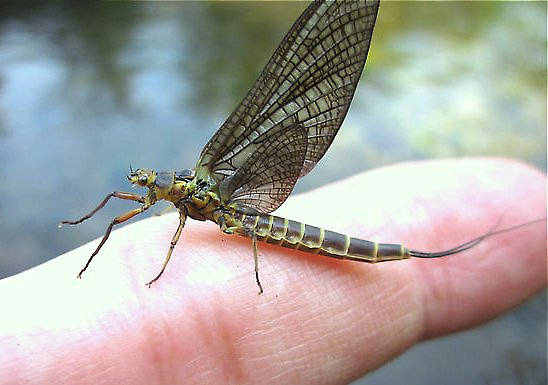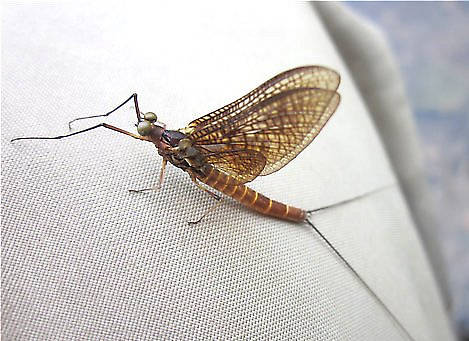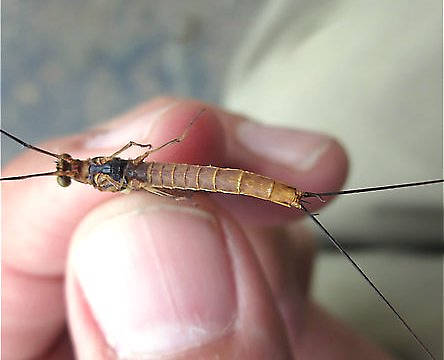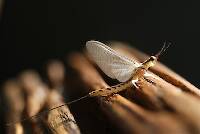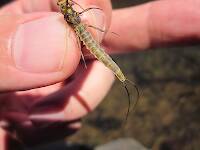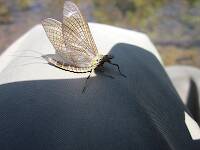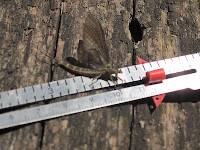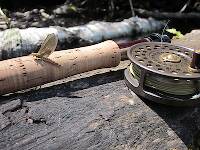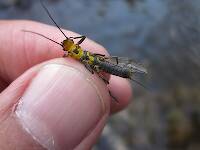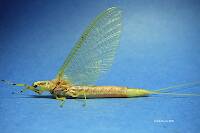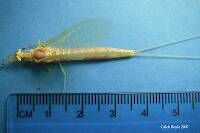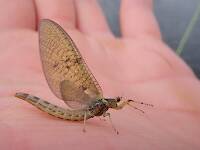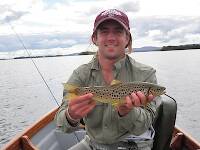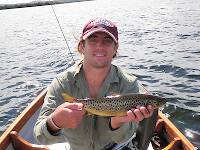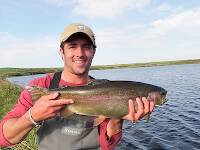
Hex Mayflies
Hexagenia limbata
The famous nocturnal Hex hatch of the Midwest (and a few other lucky locations) stirs to the surface mythically large brown trout that only touch streamers for the rest of the year.
Featured on the forum

Some characteristics from the microscope images for the tentative species id: The postero-lateral projections are found only on segment 9, not segment 8. Based on the key in Jacobus et al. (2014), it appears to key to Neoleptophlebia adoptiva or Neoleptophlebia heteronea, same as this specimen with pretty different abdominal markings. However, distinguishing between those calls for comparing the lengths of the second and third segment of the labial palp, and this one (like the other one) only seems to have two segments. So I'm stuck on them both. It's likely that the fact that they're immature nymphs stymies identification in some important way.

Troutnut is a project started in 2003 by salmonid ecologist Jason "Troutnut" Neuswanger to help anglers and
fly tyers unabashedly embrace the entomological side of the sport. Learn more about Troutnut or
support the project for an enhanced experience here.
This topic is about the Mayfly Species Litobrancha recurvata
Litobrancha recurvata is generally reported to be the largest North American species of mayfly in angler entomologies, though this understanding is being challenged by reports of Hexagenia limbata that may exceed 40mm in some locales. Regardless, it is certainly the largest mayfly in the region of its distribution. Sometimes it appears together with species of Hexagenia or Ephemera, but in other places it creates excellent action on its own.Example specimens
Entoman on May 14, 2012May 14th, 2012, 11:30 am EDT
Great photos, Eric. Wow, what a hairy faced critter. I don't remember seeing an ephemerid before whose tusks were so completely covered.
BTW - I agree with your ID. It's quite ironic that the only things on this guy's face that aren't hairy (antennae) are significant characters that connote Litobrancha.:)
BTW - I agree with your ID. It's quite ironic that the only things on this guy's face that aren't hairy (antennae) are significant characters that connote Litobrancha.:)
"It's not that I find fishing so important, it's just that I find all other endeavors of Man equally unimportant... And not nearly as much fun!" Robert Traver, Anatomy of a Fisherman
Crepuscular on May 14, 2012May 14th, 2012, 4:17 pm EDT
I really like all of the burrowers. Do you have any idea what the evolutionary benefit the single gill
on the first abdominal segment would be? I often wonder about that, just like the single gills on some of the Heptageniids.
on the first abdominal segment would be? I often wonder about that, just like the single gills on some of the Heptageniids.
Entoman on May 14, 2012May 14th, 2012, 7:49 pm EDT
Good question. I suppose a good place to start would be to find out the advantages of single vs. forked gills and vice versa. I believe that the plate-like ones of baetids and ephemerellids are more for ventilating the surface area of the body where oxygen can be adsorbed as opposed to actually functioning as pure respiratory organs. I think they also provide the vital function of salt absorption so important to freshwater creatures. If I remember right, assuming the oxygen is high enough with a little water movement, studies have shown that baetids can survive quite well with all their gills removed. The feathery forked gills of ephemerids on the other hand are purely respiratory organs, so maybe Litobrancha's preferred habitat meets their oxygen needs without the fully forked 1st gill. But it may be that like many vestigial animal characters, the answers still elude us. Finally, what the heck do I know? I'm in way over my head here, so take what I've said with a grain of salt. I have a tough enough time just trying to ID these buggers.:)
BTW - how did you collect it?
BTW - how did you collect it?
"It's not that I find fishing so important, it's just that I find all other endeavors of Man equally unimportant... And not nearly as much fun!" Robert Traver, Anatomy of a Fisherman
Crepuscular on May 14, 2012May 14th, 2012, 9:07 pm EDT
That seems reasonable to me, obviously the habitats seem to dictate gill structure to a large extent. But when you look at the gils of an Ephemerellid, Baetid, Heptageniid (any that are not fringed) they seem to be very much like a balloon. So do they function as a respiratory organ as well as a mechanical ventilation system? I seem to think that I may have known more about this at one time...I've got high mileage...
Collected by hand, I didn't have much time I was giving a demonstration to a group and had about 15 minutes to try and find some of the buggers. The stream had changed drastically since I was there last year due to flooding, and in areas where each handful of silt would give me a half dozen or so of these guys in the past, the substrate had changed and the habitat was not right. I did manage to find one place and got two and then I had to go. I may be able to get back, and I also know of at least two other streams with substantial populations.
BTW - how did you collect it?
Collected by hand, I didn't have much time I was giving a demonstration to a group and had about 15 minutes to try and find some of the buggers. The stream had changed drastically since I was there last year due to flooding, and in areas where each handful of silt would give me a half dozen or so of these guys in the past, the substrate had changed and the habitat was not right. I did manage to find one place and got two and then I had to go. I may be able to get back, and I also know of at least two other streams with substantial populations.
Quick Reply
Related Discussions
Topic
Replies
Last Reply
1
Aug 1, 2008
by Troutnut
by Troutnut
3
May 31, 2016
by Oldredbarn
by Oldredbarn
2
Sep 11, 2010
by Adirman
by Adirman
10
Feb 27, 2012
by Oldredbarn
by Oldredbarn
17
Jun 2, 2008
by Woodster
by Woodster
7
Feb 6, 2013
by Entoman
by Entoman


